The Detection of Active Sinkholes by Airborne Differential LiDAR DEMs and InSAR Cloud Computing Tools
Abstract
:1. Introduction
2. Geological Setting
3. Materials and Methods
- Two surface velocity maps with a spatial resolution of 80 by 80 m (4 looks in the range direction and 20 in the azimuth one) using the SBAS Envisat algorithm by processing 25 archived ASAR images of the Envisat satellite acquired on ascending orbit from 25 June 2004 to 17 September 2010 (track 152, frame 58), and 29 archived ASAR images of the Envisat satellite acquired on descending orbit from 19 June 2003 to 30 September 2010 (track 101, frame 152).
- Four surface velocity maps with a spatial resolution of 90 by 90 m using the SBAS Sentinel approach by processing 74 archived SLC_IW images of the Sentinel S1 satellite acquired on ascending orbit from 5 November 2014 to 26 January 2021 (track 103), 51 archived SLC_IW images of the Sentinel S1 satellite acquired on descending orbit from 9 June 2016 to 26 January 2021 (track 8), 100 archived SLC_IW images of the Sentinel S1 satellite acquired on ascending orbit from 13 June 2019 to 20 February 2021 (track 30), and 100 archived SLC_IW images of the Sentinel S1 satellite acquired on descending orbit from 12 June 2019 to 19 February 2021 (track 8).
- Four surface velocity maps to cover the study area with a spatial resolution of 40 by 40 m using the FASTVEL Sentinel algorithm by processing 400 archived SLC_IW images of the Sentinel S1 acquired on descending orbit from 12 July 2017 to 21 March 2021 (track 8).
4. Results
4.1. Active Sinkhole Detection by LiDAR Displacement Maps
4.2. Zuera Sinkholes Site
4.3. Active Sinkholes in the Ebro River Valley
4.4. Measuring Subsidence Rates in Active Sinkholes
5. Discussion
5.1. Advantages and Limitations of Airborne LiDAR and Web-Based InSAR Processing Tools
5.2. Implications of InSAR Cloud Computing and Differential LiDAR in Sinkhole Risk Management
6. Conclusions
Supplementary Materials
Author Contributions
Funding
Institutional Review Board Statement
Informed Consent Statement
Data Availability Statement
Conflicts of Interest
References
- Soriano, M.A.; Simón, J.L. Subsidence rates and urban damages in alluvial dolines in the Central Ebro basin (NE Spain). Environ. Geol. 2002, 42, 476–484. [Google Scholar]
- Simón, J.L.; Soriano, M.A.; Arlegui, L.E.; Gracia, F.J.; Liesa, C.L.; Pocoví, A. Space–time distribution of ancient and active alluvial karst subsidence: Examples from central Ebro Basin, Spain. Environ. Geol. 2008, 53, 1057–1065. [Google Scholar] [CrossRef]
- Galve, J.P.; Gutiérrez, F.; Lucha, P.; Bonachea, J.; Remondo, J.; Cendrero, A.; Gutiérrez, M.; Gimeno, M.; Pardo, G.; Sánchez, J. Sinkholes in the salt-bearing evaporite karst of the Ebro River valley upstream of Zaragoza city (NE Spain). Geomorphological mapping and analysis as a basis for risk management. Geomorphology 2009, 108, 145–158. [Google Scholar] [CrossRef]
- Guerrero, J.; Gutiérrez, F.; Galve, J. Large depressions, thickened terraces and gravitational deformation in the Ebro River valley (Zaragoza area, NE Spain). Evidence of glauberite and halite interstratal karstification. Geomorphology 2013, 196, 162–176. [Google Scholar] [CrossRef]
- Rahimi, M.; Alexander, E.C. Locating sinkholes in LiDAR coverage of a glacio-fluvial karst, Winona County, MN. In NCKRI Symposium 2, Proceedings of the 13th Multidisciplinary Conference on Sinkholes and the Engineering and Environmental Impacts of Karst, Carlsbad, NM, USA, 22 May 2013; Land, L., Doctor, D.H., Stephenson, J.B., Eds.; National Cave and Karst Research Institute: Carlsbad, NM, USA, 2013; pp. 469–480. [Google Scholar]
- Filin, S.; Baruch, A.; Avni, Y.; Marco, S. Sinkhole characterization in the Dead Sea using airborne laser scanning. Nat. Hazards 2011, 58, 1135–1154. [Google Scholar] [CrossRef]
- Panno, S.V.; Luman, D.E. Characterization of cover-collapse sinkhole morphology on a groundwater basin-wide scale using lidar elevation data: A new conceptual model for sinkhole evolution. Geomorphology 2018, 318, 1–17. [Google Scholar] [CrossRef]
- Gökkaya, E.; Gutiérrez, F.; Ferk, M.; Görüm, T. Sinkhole development in the Sivas gypsum karst. Turkey. Geomorphology 2021, 386, 107746. [Google Scholar] [CrossRef]
- Kobal, M.; Bertoncelj, I.; Pirotti, F.; Dakskobler, I.; Kutnar, L. Using Lidar Data to Analyse Sinkhole Characteristics Relevant for Understory Vegetation under Forest Cover—Case Study of a High Karst Area in the Dinaric Mountains. PLoS ONE 2015, 10, e0122070. [Google Scholar] [CrossRef] [PubMed] [Green Version]
- González-Díez, A.; Barreda-Argüeso, J.A.; Rodríguez-Rodríguez, L.; Fernández-Lozano, J. The use of filters based on the Fast Fourier Transform applied to DEMs for the objective mapping of karstic features. Geomorphology 2021, 385, 107724. [Google Scholar] [CrossRef]
- Filin, S.; Baruch, A. Detection of sinkhole hazards using airborne laser scanning data. Photogramm. Eng. Remote Sens. 2010, 76, 577–587. [Google Scholar] [CrossRef]
- Doctor, D.H.; Young, J.A. An evaluation of automated gis tools for delineating karst sinkholes and closed depressions from 1-m lidar-derived digital elevation data. In NCKRI Symposium 2, Proceedings of the 13th Multidisciplinary Conference on Sinkholes and the Engineering and Environmental Impacts of Karst, Carlsbad, NM, USA, 22 May 2013; Land, L., Doctor, D.H., Stephenson, J.B., Eds.; National Cave and Karst Research Institute: Carlsbad, NM, USA, 2013; pp. 449–458. [Google Scholar]
- Obu, J.; Podobnikar, T. Algorithm for karst depression recognition using digital terrain models. Geodetski Vestnik 2013, 57, 260–270. [Google Scholar] [CrossRef]
- Zhu, J.; Taylor, T.P.; Currens, J.C.; Crawford, M.M. Improved karst sinkhole mapping in Kentucky using LiDAR techniques: A pilot study in Floyds Fork Watershed. J. Cave Karst Stud. 2014, 76, 207–216. [Google Scholar] [CrossRef]
- Kim, Y.J.; Nam, B.H.; Youn, H. Sinkhole Detection and Characterization Using LiDAR-Derived DEM with Logistic Regression. Remote Sens. 2019, 11, 1592. [Google Scholar] [CrossRef] [Green Version]
- Zhu, J.; Nolte, A.M.; Jacobs, N.; Ye, M. Using machine learning to identify karst sinkholes from LiDAR-derived topographic depressions in the Bluegrass Region of Kentucky. J. Hydrol. 2020, 588, 125049. [Google Scholar] [CrossRef]
- Hofierka, J.; Gallay, M.; Bandura, P.; Šašak, J. Identification of karst sinkholes in a forested karst landscape using airborne laser scanning data and water flow analysis. Geomorphology 2018, 308, 265–277. [Google Scholar] [CrossRef]
- Gutiérrez, F. Sinkhole hazards. In Oxford Research Encyclopedia of Natural Hazard Science; Oxford University Press: Oxford, UK, 2016; Available online: https://oxfordre.com/naturalhazardscience/view/10.1093/acrefore/9780199389407.001.0001/acrefore-9780199389407-e-40 (accessed on 7 July 2016).
- Avni, Y.; Lensky, N.; Dente, E.; Shviro, M.; Arav, R.; Gavrieli, I.; Yechieli, J.; Abelson, M.; Lutzky, H.; Filin, S.; et al. Self-accelerated development of salt karst during flash floods along the Dead Sea Coast, Israel. J. Geophys. Res. Earth Surf. 2016, 121, 17–38. [Google Scholar] [CrossRef] [Green Version]
- Kent, J.D.; Dunaway, L. Real-time GPS network monitors Bayou Corne sinkhole event. Eos 2013, 94, 385–386. [Google Scholar] [CrossRef]
- Kersten, T.; Kobe, M.; Gabriel, G.; Timmen, L.; Schon, S.; Vogel, D. Geodetic monitoring of suberosion-induced subsidence processes in urban areas. J. Appl. Geod. 2017, 11, 21–29. [Google Scholar]
- Desir, G.; Gutiérrez, F.; Merino, J.; Carbonel, D.; Benito-Calvo, A.; Guerrero, J.; Fabregat, I. Rapid subsidence in damaging sinkholes: Measurements by high-precision leveling and the role of salt dissolution. Geomorphology 2018, 303, 393–409. [Google Scholar] [CrossRef]
- Gutiérrez, F.; Benito-Calvo, A.; Carbonel, D.; Desir, G.; Sevil, J.; Guerrero, J.; Martinez-Fernandez, A.; Karamplaglidis, T.; Garcia-Arnay, A.; Fabregat, I. Review on sinkhole monitoring and performance of remediation measures by high-precision leveling and terrestrial laser scanner in the salt karst of the Ebro Valley, Spain. Eng. Geol. 2019, 248, 283–308. [Google Scholar] [CrossRef]
- Nof, R.N.; Baer, G.; Ziv, A.; Raz, E.; Atzori, S.; Salvi, S. Sinkhole precursors along the Dead Sea, Israel, revealed by SAR interferometry. Geology 2013, 41, 1019–1022. [Google Scholar] [CrossRef]
- Baer, G.; Magen, Y.; Nof, R.N.; Raz, E.; Lyakhovsky, V.; Shalev, E. InSAR measurements and viscoelastic modelling of sinkhole precursory subsidence: Implication for sinkhole formation, early warning and sediment properties. J. Geophy. Res. 2018, 123, 678–693. [Google Scholar] [CrossRef]
- Shi, Y.; Tang, Y.; Lu, Z.; Kim, J.W.; Peng, J. Subsidence of sinkholes in Wink, Texas from 2007 to 2011 detected by time-series InSAR analysis. Geomat. Nat. Hazards Risk 2019, 10, 1125–1138. [Google Scholar] [CrossRef]
- Solari, L.; Montalti, R.; Barra, A.; Monserrat, O.; Bianchini, S.; Crosetto, M. Multi-Temporal Satellite Interferometry for Fast-Motion Detection: An Application to Salt Solution Mining. Remote Sens. 2020, 12, 3919. [Google Scholar] [CrossRef]
- Orhan, O.; Oliver-Cabrera, T.; Wdowinski, S.; Yalvac, S.; Yakar, M. Land subsidence and its relations with sinkhole activity in Karapınar region, Turkey: A multi-sensor InSAR time series study. Sensors 2021, 21, 774. [Google Scholar] [CrossRef] [PubMed]
- Busetti, A.; Calligaris, C.; Forte, E.; Areggi, G.; Mocnik, A.; Zini, L. Non-Invasive Methodological Approach to Detect and Characterize High-Risk Sinkholes in Urban Cover Evaporite Karst: Integrated Reflection Seismics, PS-InSAR, Leveling, 3D-GPR and Ancillary Data. A NE Italian Case Study. Remote. Sens. 2020, 12, 3814. [Google Scholar] [CrossRef]
- Intrieri, E.; Gigli, G.; Nocentini, M.; Lombardi, L.; Mugnai, F.; Fidolini, F.; Casagli, N. Sinkhole monitoring and early warning: An experimental and successful GBInSAR application. Geomorphology 2015, 241, 304–314. [Google Scholar] [CrossRef] [Green Version]
- Benito-Calvo, A.; Gutiérrez, F.; Martinez-Fernandez, A.; Carbonel, D.; Karampaglidis, T.; Desir, G.; Sevil, J.; Guerrero, J.; Fabregat, I.; Garcia-Arnay, A. 4D monitoring of active sinkholes with Terrestrial Laser Scanner (TLS). A case study in the evaporate karst of the Ebro Valley, NE Spain. Remote Sens. 2018, 10, 571. [Google Scholar] [CrossRef] [Green Version]
- Sevil, J.; Benito-Calvo, A.; Gutiérrez, F. Sinkhole subsidence monitoring combining terrestrial laser scanner and high-precision levelling. Earth Surf. Process. Landf. 2021, 46. [Google Scholar] [CrossRef]
- Al-Halbouni, D.; Holohan, E.P.; Saberi, L.; Alrshdan, H.; Sawarieh, A.; Closson, D.; Walter, T.R.; Dahm, T. Sinkholes, subsidence and suberosion on the eastern shore of the Dead Sea as revealed by close-range photogrammetry survey. Geomorphology 2017, 285, 305–324. [Google Scholar] [CrossRef] [Green Version]
- Meredith, A.; Eslinger, D.; Aurin, D. An Evaluation of Hurricane-Induced Erosion along the North Carolina Coast Using Airborne LiDAR Surveys; United States Department of Commerce, NOAA Coastal Services Center Technical Report/99031-PUB: Charleston, SC, USA, 1999; pp. 1–30.
- Mitasova, H.; Hardin, E.; Overton, M.F.; Kurum, M.O. Geospatial analysis of vulnerable beach-foredune systems from decadal time series of LiDAR data. J. Coast. Conserv. 2010, 14, 161–172. [Google Scholar] [CrossRef] [Green Version]
- Obu, J.; Lantuit, H.; Grosse, G.; Günther, F.; Sachs, T.; Helm, V.; Fritz, M. Coastal erosion and mass wasting along the Canadian Beaufort Sea based on annual airborne LiDAR elevation data. Geomorphology 2017, 293, 331–346. [Google Scholar] [CrossRef] [Green Version]
- Geist, T.; Lutz, E.; Stoetter, J. Airborne laser scanning technology and its potential for applications in glaciology. In 3D Reconstruction from Airborne Laser Scanner and InSAR Data, Proceedings of the ISPRS Workshop, Dresden, Germany, 10 October 2003; Maas, H.G., Vosselman, G., Streilein, A., Eds.; ISPRS Archives: Dresden, Germany, 2003; pp. 1–5. [Google Scholar]
- Irvine-Fynn, T.D.L.; Barrand, N.E.; Porter, P.R.; Hodson, A.J.; Murray, T. Recent high-arctic glacial sediment redistribution: A process perspective using airborne LiDAR. Geomorphology 2011, 125, 27–39. [Google Scholar] [CrossRef]
- Telling, J.W.; Glennie, C.; Fountain, A.G.; Finnegan, D.C. Analyzing Glacier Surface Motion Using LiDAR Data. Remote Sens. 2017, 9, 283. [Google Scholar] [CrossRef] [Green Version]
- Glennie, C.L.; Hinojosa-Corona, A.; Nissen, E.; Kusari, A.; Oskin, M.E.; Arrowsmith, J.R.; Borsa, A. Optimization of legacy LiDAR data sets for measuring near-field earthquake displacements. Geophys. Res. Lett. 2014, 41, 3494–3501. [Google Scholar] [CrossRef]
- Clark, K.J.; Nissen, E.K.; Howarth, J.D.; Hamling, I.J.; Mountjoy, J.J.; Ries, W.F.; Jones, K.; Goldstien, S.; Cochran, U.A.; Villamor, P.; et al. Highly variable coastal deformation in the 2016 MW7.8 Kaikōura earthquake reflects rupture complexity along a transpressional plate boundary. Earth Planet. Sci. Lett. 2017, 474, 334–344. [Google Scholar] [CrossRef]
- Favalli, M.; Fornaciai, A.; Mazzarini, F.; Harris, A.J.L.; Neri, M.; Behncke, B.; Pareschi, M.T.; Tarquini, S.; Boschi, E. Evolution of an active lava flow field using a multi-temporal LiDAR acquisition. J. Geophys. Res. Solid Earth 2010, 115, 1–17. [Google Scholar] [CrossRef] [Green Version]
- Behncke, B.; Fornaciai, A.; Neri, M.; Favalli, M.; Ganci, G.; Mazzarini, F. LiDAR surveys reveal eruptive volumes and rates at Etna, 2007–2010. Geophys. Res. Lett. 2016, 43, 4270–4278. [Google Scholar] [CrossRef] [Green Version]
- Corsini, A.; Borgatti, L.; Cervi, F.; Dahne, A.; Ronchetti, F.; Sterzai, P. Estimating mass-wasting processes in active earth slides —Earth flows with time-series of high resolution DEMs from photogrammetry and airborne LiDAR. Nat. Hazards Earth Syst. Sci. 2009, 9, 433–439. [Google Scholar] [CrossRef]
- Ventura, G.; Vilardo, G.; Terranova, C.; Sessa, E.B. Tracking and evolution of complex active landslides by multi-temporal airborne LiDAR data: The Montaguto landslide (Southern Italy). Remote Sens. Environ. 2011, 115, 3237–3248. [Google Scholar] [CrossRef]
- Tseng, C.M.; Lin, C.W.; Stark, C.P.; Liu, J.K.; Fei, L.Y.; Hsieh, Y.C. Application of a multi-temporal, LiDAR-derived, digital terrain model in a landslide-volume estimation. Earth Surf. Process. Landf. 2013, 38, 1587–1601. [Google Scholar] [CrossRef]
- Khan, S.D.; Huang, Z.; Karacay, A. Study of ground subsidence in northwest Harris county using GPS, LiDAR, and InSAR techniques. Nat. Hazards 2014, 73, 1143–1173. [Google Scholar] [CrossRef]
- Densmore, J.N.; Ellett, K.M.; Sneed, M.; Brandt, J.T.; Howle, J.F.; Morita, A.Y.; Borela, R.; Bobet, A.; Thayer, D.C. Evaluation of land subsidence and ground failures at Bicycle Basin, Fort Irwin National Training Center, California, 1992–2017. Sci. Investig. Rep. US Geol. Surv. 2019, 5015, 1–93. [Google Scholar]
- Quirantes, J. Sedimentological and Stratigraphic Study of the Continental Tertiary Sequence of Monegros; Institución Fernando El Católico (CSIC), Diputación Provincial de Zaragoza: Zaragoza, Spain, 1978; pp. 1–207. (In Spanish) [Google Scholar]
- Torrescusa, S.; Klimowitz, J. Knowledge contribution of the Miocene evaporites (Zaragoza Formation) of the Ebro Basin. In Formaciones Evaporíticas de la Cuenca del Ebro y Cadenas Periféricas y de la Zona de Levante; Ortí, F., Salvany, J.M., Eds.; ENRESA-GPG: Barcelona, Spain, 1990; pp. 120–122. (In Spanish) [Google Scholar]
- Salvany, J.M. Geology of glauberite layers of the Montes de Torrero; Universidad de Zaragoza: Zaragoza, Spain, 2009. (In Spanish) [Google Scholar]
- Acero, P.; Gutiérrez, F.; Galve, J.P.; Auqué, L.F.; Carbonel, D.; Gimeno, M.J.; Gómez, J.B.; Asta, M.P.; Yechieli, Y. Hydrogeochemical characterization of an evaporite karst area affected by sinkholes (Ebro Valley, NE Spain). Geol. Acta 2013, 11, 337–355. [Google Scholar]
- Acero, P.; Auqué, L.; Galve, J.P.; Gutiérrez, F.; Carbonel, D.; Gimeno, M.J.; Yechieli, Y.; Asta, M.P.; Gómez, J.B. Evaluation of geochemical and hydrogeological processes by geochemical modelling in an area affected by evaporite karstification. J. Hydrology 2015, 529, 1874–1889. [Google Scholar] [CrossRef]
- Gutierrez, F.; Mozafari, M.; Carbonel, D.; Gomez, R.; Raeisi, E. Leakage problems in dams built on evaporites. The case of La Loteta Dam (NE Spain), a reservoir in a large karstic depression generated by interstratal salt dissolution. Eng. Geol. 2015, 185, 139–154. [Google Scholar] [CrossRef]
- Salvany, J.M.; García-Veigas, J.; Ortí, F. Glauberite-halite association of the Zaragoza Gypsum Formation (Lower Miocene, Ebro Basin, NE Spain). Sedimentology 2007, 54, 443–467. [Google Scholar] [CrossRef]
- Zarroca, M.; Comas, X.; Gutiérrez, F.; Carbonel, D.; Linares, R.; Roqué, C.; Guerrero, J.; Pellicer, X. The application of GPR and ERI in combination with exposure logging and retrodeformation analysis to characterize sinkholes and reconstruct their impact on fluvial sedimentation. Gállego Valley, NE Spain. Earth Surf. Process. Landf. 2016, 42, 1049–1069. [Google Scholar] [CrossRef]
- Gutiérrez, F.; Galve, J.P.; Lucha, P.; Bonachea, J.; Jordá, L.; Jordá, R. Investigation of a large collapse sinkhole affecting a multi-storey building by means of geophysics and the trenching technique (Zaragoza city, NE Spain). Environ. Geol. 2009, 58, 1107–1122. [Google Scholar] [CrossRef]
- Gutiérrez, F.; Galve, J.P.; Lucha, P.; Castañeda, C.; Bonachea, J.; Guerrero, J. Integrating geomorphological mapping, trenching, InSAR and GPR for the identification and characterization of sinkholes in the mantled evaporite karst of the Ebro Valley (NE Spain). Geomorphology 2011, 134, 144–156. [Google Scholar] [CrossRef] [Green Version]
- Gutiérrez, F.; Zarroca, M.; Linares, R.; Roqué, C.; Carbonel, D.; Guerrero, J.; McCalpin, J.; Comas, X.; Cooper, A. Identifying the boundaries of sinkholes and subsidence areas via trenching and stablishing setback distances. Eng. Geol. 2018, 233, 255–268. [Google Scholar] [CrossRef]
- Carbonel, D.; Rodríguez, V.; Gutiérrez, F.; Mccalpin, J.P.; Linares, R.; Roqué, C.; Zarroca, M.; Guerrero, J.; Sasowsky, I. Evaluation of trenching, ground penetrating radar (GPR) and electrical resistivity tomography (ERT) for sinkhole characterization. Earth Surf. Process. Landf. 2013, 39, 3440. [Google Scholar] [CrossRef]
- Carbonel, D.; Rodríguez-Tribaldos, V.; Gutiérrez, F.; Galve, J.P.; Guerrero, J.; Zarroca, M.; Roqué, C.; Linares, R.; McCalpin, J.P. Investigating a damaging buried sinkhole cluster in an urban area integrating multiple techniques: Geomorphological surveys, DInSAR, GPR, ERT, and trenching. Geomorphology 2015, 229, 3–16. [Google Scholar] [CrossRef]
- Sevil, J.; Gutiérrez, F.; Zarroca, M.; Desir, G.; Carbonel, D.; Guerrero, J.; Linares, R.; Roqué, C.; Fabregat, I. Sinkhole investigation in an urban area by trenching in combination with GPR, ERT and high-precision leveling. Mantled evaporite karst of Zaragoza city, NE Spain. Eng. Geol. 2017, 231, 9–20. [Google Scholar] [CrossRef]
- Rodríguez, V.; Gutiérrez, F.; Green, A.G.; Carbonel, D.; Horstmeyer, H.; Schmelzbach, C. Characterizing sagging and collapse sinkholes in a mantled karst by means of ground penetrating radar (GPR). Environ. Eng. Geosc. 2014, 20, 109–132. [Google Scholar] [CrossRef]
- Galve, J.P.; Castaneda, C.; Gutierrez, F.; Herrera, G. Assessing sinkhole activity in the Ebro Valley mantled evaporite karst using advanced DInSAR. Geomorphology 2015, 229, 30–44. [Google Scholar] [CrossRef] [Green Version]
- Sevil, J.; Gutiérrez, F.; Carnicer, C.; Carbonel, D.; Desir, G.; García-Arnay, A.; Guerrero, J. Characterizing and monitoring a high-risk sinkhole in an urban area underlain by salt through non-invasive methods: Detailed mapping, high precision leveling and GPR. Eng. Geol. 2020, 272, 105641. [Google Scholar] [CrossRef]
- Gutiérrez, F.; Guerrero, J.; Lucha, P.; Gutierrez, F. A genetic classification of sinkholes illustrated from evaporite paleokarst exposures in Spain. Environ. Geol. 2008, 53, 993–1006. [Google Scholar] [CrossRef]
- ASPRS, Laser File Format Exchange Activities. Available online: https://www.asprs.org/committee%E2%80%90general/laser%E2%80%90las%E2%80%90file%E2%80%90formatexchange%E2%80%90activities.html (accessed on 14 June 2016).
- Axelsson, P. Processing of laser scanner data-algorithms and applications. ISPRS P&RS 1999, 54, 138–147. [Google Scholar]
- Axelsson, P. DEM generation from laser scanner data using adaptive TIN models. ISPRS Arch. 2000, 33, 110–117. [Google Scholar]
- Lorite Martínez, S.; Ojeda, J.C.; Rodríguez-Cuenca, R.; González, E.; Muñoz, P. Point cloud distribution and processing of the PNOA-LiDAR Project. Available online: http://pnoa.ign.es/PNOAtheme/images/imgPNOA/contenidos/pdf/Procesado_distribucion_nubes_puntos_proyecto_PNOA-LiDAR.pdf (accessed on 14 June 2016). (In Spanish).
- Montealegre, A.; Lamelas, M.T.; De la Riva, J. A comparison of open-source LiDAR filtering algorithms in a mediterranean forest environment. IEEE J. Sel. Top. Appl. Earth Obs. Remote Sens. 2015, 8, 4072–4085. [Google Scholar] [CrossRef] [Green Version]
- Zhao, X.; Su, Y.; Li, W.; Hu, T.; Liu, J.; Guo, Q. A Comparison of LiDAR Filtering Algorithms in Vegetated Mountain Areas. Can. J. Remote Sens. 2018, 44, 287–298. [Google Scholar] [CrossRef]
- Casu, F.; Elefante, E.; Imperatore, P.; Zinno, I.; Manunta, M.; De Luca, C.; Lanari, R. SBAS-DInSAR Parallel Processing for Deformation Time Series Computation. IEEE JSTARS 2014, 7. [Google Scholar] [CrossRef]
- De Luca, C.; Cuccu, R.; Elefante, S.; Zinno, I.; Manunta, M.; Casola, V.; Rivolta, G.; Lanari, R.; Casu, F. An On-Demand Web Tool for the Unsupervised Retrieval of Earth’s Surface Deformation from SAR Data: The P-SBAS Service within the ESA G-POD Environment. Remote Sens. 2015, 7, 15630–15650. [Google Scholar] [CrossRef] [Green Version]
- Galve, J.; Pérez-Peña, J.; Azañón, J.; Closson, D.; Caló, F.; Reyes-Carmona, C.; Jabaloy, A.; Ruano, P.; Mateos, R.; Notti, D.; et al. Evaluation of the SBAS InSAR service of the European space Agency’s Geohazard Exploitation Platform (GEP). Remote Sens. 2017, 9, 1291. [Google Scholar] [CrossRef] [Green Version]
- Manunta, M.; De Luca, C.; Zinno, I.; Casu, F.; Manzo, M.; Bonano, M.; Fusco, A.; Giovanni, A.; Berardino, P.; De Maertino, P.; et al. The Parallel SBAS Approach for Sentinel-1 Interferometric Wide Swath Deformation Time-Series Generation: Algorithm Description and Products Quality Assessment. IEEE Trans. Geosci. Remote Sens. 2019, 57, 6259–6281. [Google Scholar] [CrossRef]
- Piroton, V.; Schlögel, R.; Barbier, C.; Havenith, H. Monitoring the Recent Activity of Landslides in the Mailuu-Suu Valley (Kyrgyzstan) Using Radar and Optical Remote Sensing Techniques. Geosciences 2020, 10, 164. [Google Scholar] [CrossRef]
- Bejar, M.; Notti, D.; Mateos, R.; Ezquerro, P.; Centolanza, G.; Herrera, G.; Bru, G.; Sanabria, M.; Solari, L.; Duro, J.; et al. Mapping Vulnerable Urban Areas Affected by Slow-Moving Landslides Using Sentinel-1 InSAR Data. Remote. Sens. 2017, 9, 876. [Google Scholar] [CrossRef] [Green Version]
- Raspini, F.; Cigna, F.; Moretti, S. Multi-Temporal Mapping of Land Subsidence at Basin Scale Exploiting Persistent Scatterer Interferometry: Case Study of Gioia Tauro Plain (Italy). J. Maps 2012, 8, 514–524. [Google Scholar] [CrossRef] [Green Version]
- Notti, D.; Herrera, G.; Bianchini, S.; Meisina, C.; García-Davalillo, J.C.; Zucca, F.A. Methodology for improving landslide PSI data analysis. Int. J. Remote Sens. 2014, 35, 2186–2214. [Google Scholar] [CrossRef]
- Benito, G.; Pérez-González, A.; Gutiérrez, F.; Machado, M.J. River response to Quaternary subsidence due to evaporite solution (Gállego River, Ebro Basin, Spain). Geomorphology 1998, 22, 243–263. [Google Scholar] [CrossRef]
- Parkhurst, D.L.; Appelo, C.A.J. Description of input and examples for PHREEQC version 3-A computer program for speciation, batch-reaction, one-dimensional transport, and inverse geochemical calculations. U.S. Geol. Surv. Tech. Methods 2013, 6, A43. [Google Scholar]
- Gutiérrez, M.; Gutiérrez, F. Geomorphology of the Tertiary gypsum formations in the Ebro Depression (Spain). Geoderma 1998, 87, 1–29. [Google Scholar]
- Zebker, H.; Villasenor, J. Decorrelation in interferometric radar echoes. IEEE Trans. Geosci. Remote Sens. 1992, 30, 950–959. [Google Scholar] [CrossRef] [Green Version]
- Jones, C.E.; Blom, R.G. Bayou Corne, Louisiana, sinkhole: Precursory deformation measured by radar interferometry. Geology 2014, 42, 111–114. [Google Scholar] [CrossRef]
- Jones, E.J. Capabilities, limitation and opportunities for studying sinkholes using synthetic aperture radar interferometry. In Proceedings of the 16th Multidisciplinary Conference on Sinkholes and the Engineering and Environmental Impacts of Karst and the 3rd Appalachian Symposium, Puerto Rico, USA, 12–16 April 2021; Sasowsky, M.J., Byle, L.L., Eds.; National Cave and Karst Research Institute: Puerto Rico, PR, USA, 2021; pp. 68–74. [Google Scholar]
- Nof, R.N.; Abelson, M.; Raz, E.; Magen, Y.; Atzori, S.; Salvi, S.; Baer, G. SAR Interferometry for Sinkhole Early Warning and Susceptibility Assessment along the Dead Sea, Israel. Remote Sens. 2019, 11, 89. [Google Scholar] [CrossRef] [Green Version]
- Oliver-Cabrera, T.; Wdowinski, S.; Kruse, S.; Robinson, T. InSAR Detection of Localized Subsidence Induced by Sinkhole Activity in Suburban West-Central Florida. PIAHS 2020, 382, 155–159. [Google Scholar]
- Yang, C.; Zhang, Q.; Zhao, C.; Ji, L.; Zhu, W. Monitoring mine collapse by D-InSAR. Min. Sci. Technol. 2010, 20, 696–700. [Google Scholar] [CrossRef]
- Ma, G.; Zhao, Q.; Wang, Q.; Liu, M. On the Effects of InSAR Temporal Decorrelation and Its Implications for Land Cover Classification: The Case of the Ocean-Reclaimed Lands of the Shanghai Megacity. Sensors 2018, 18, 2939. [Google Scholar] [CrossRef] [Green Version]
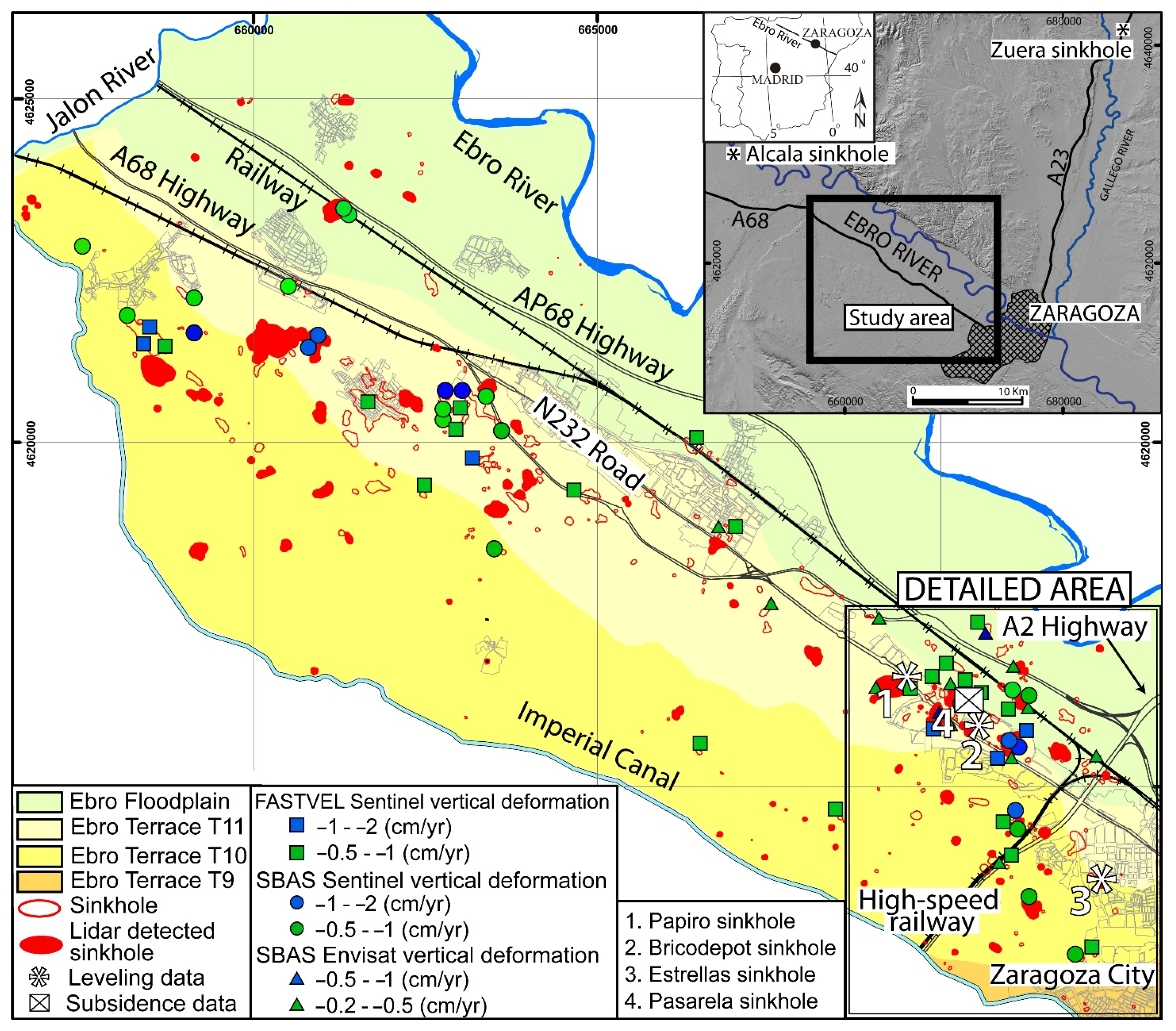
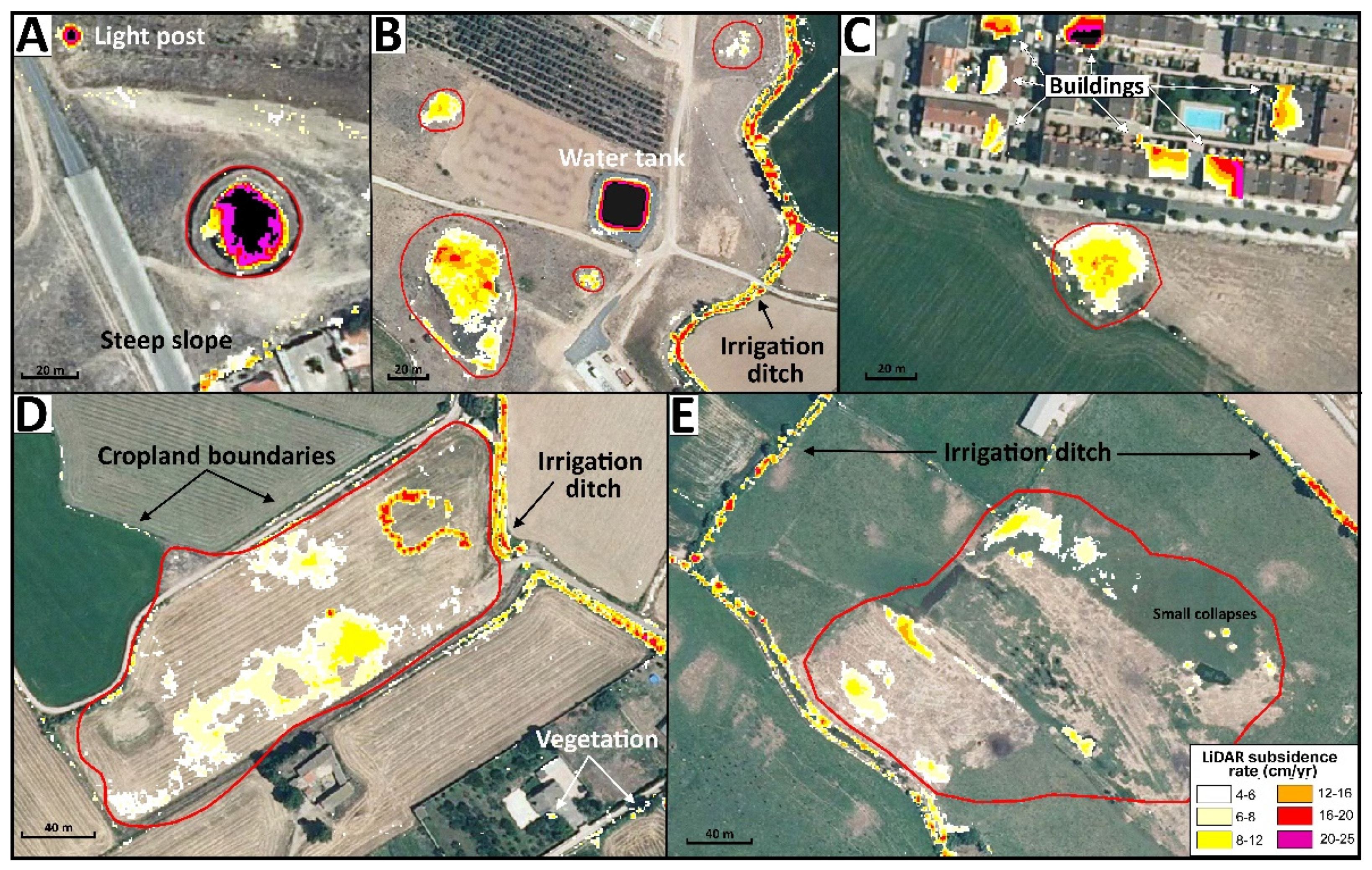
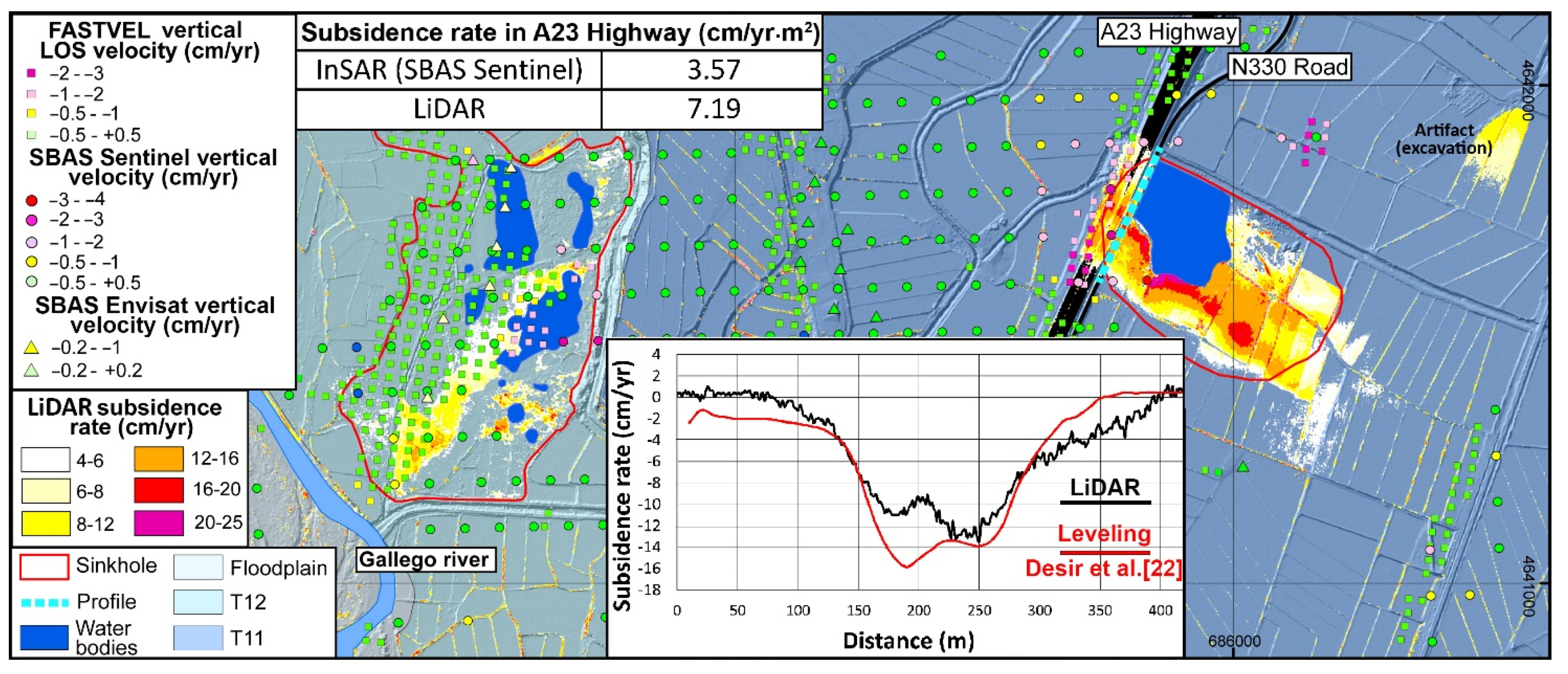
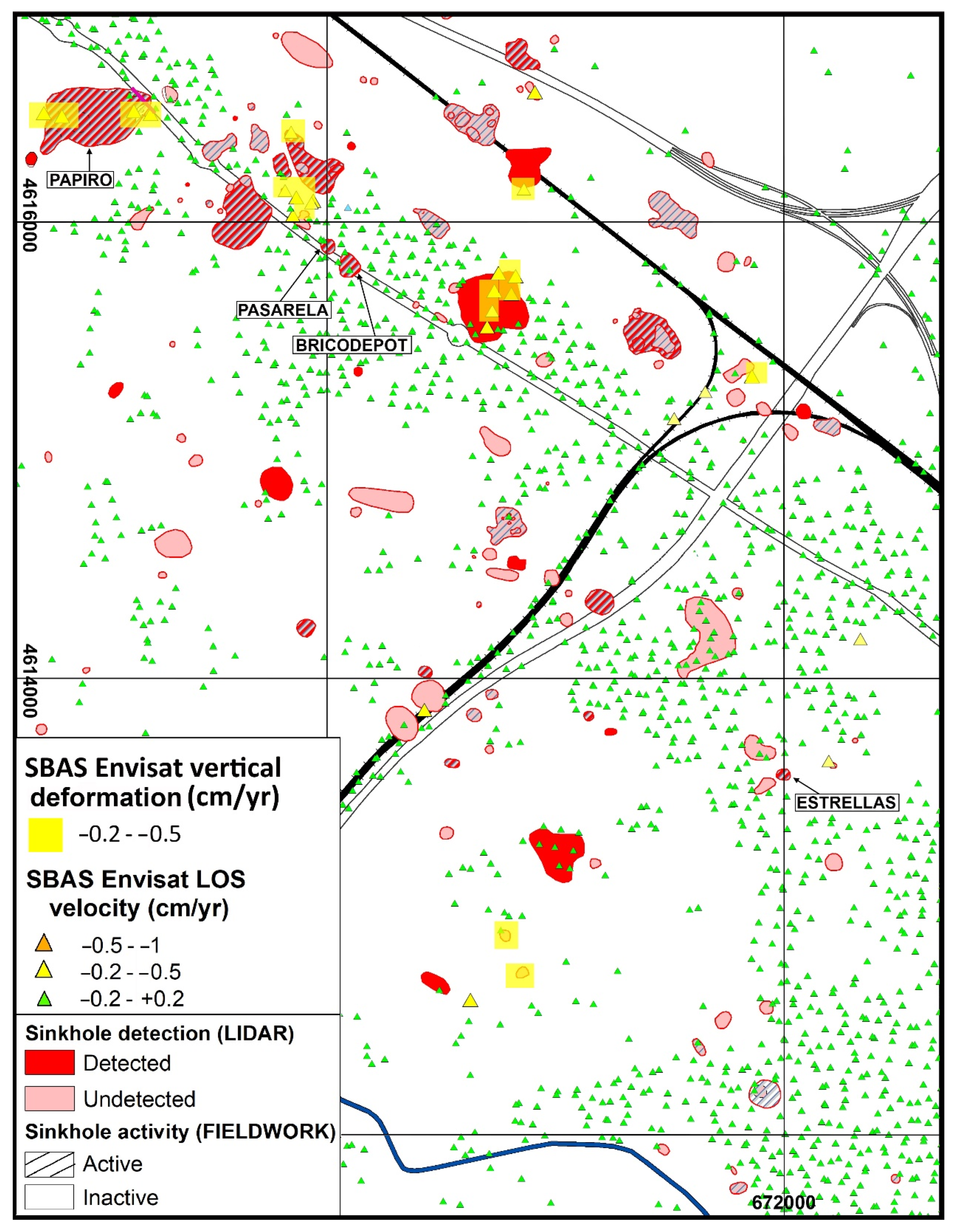
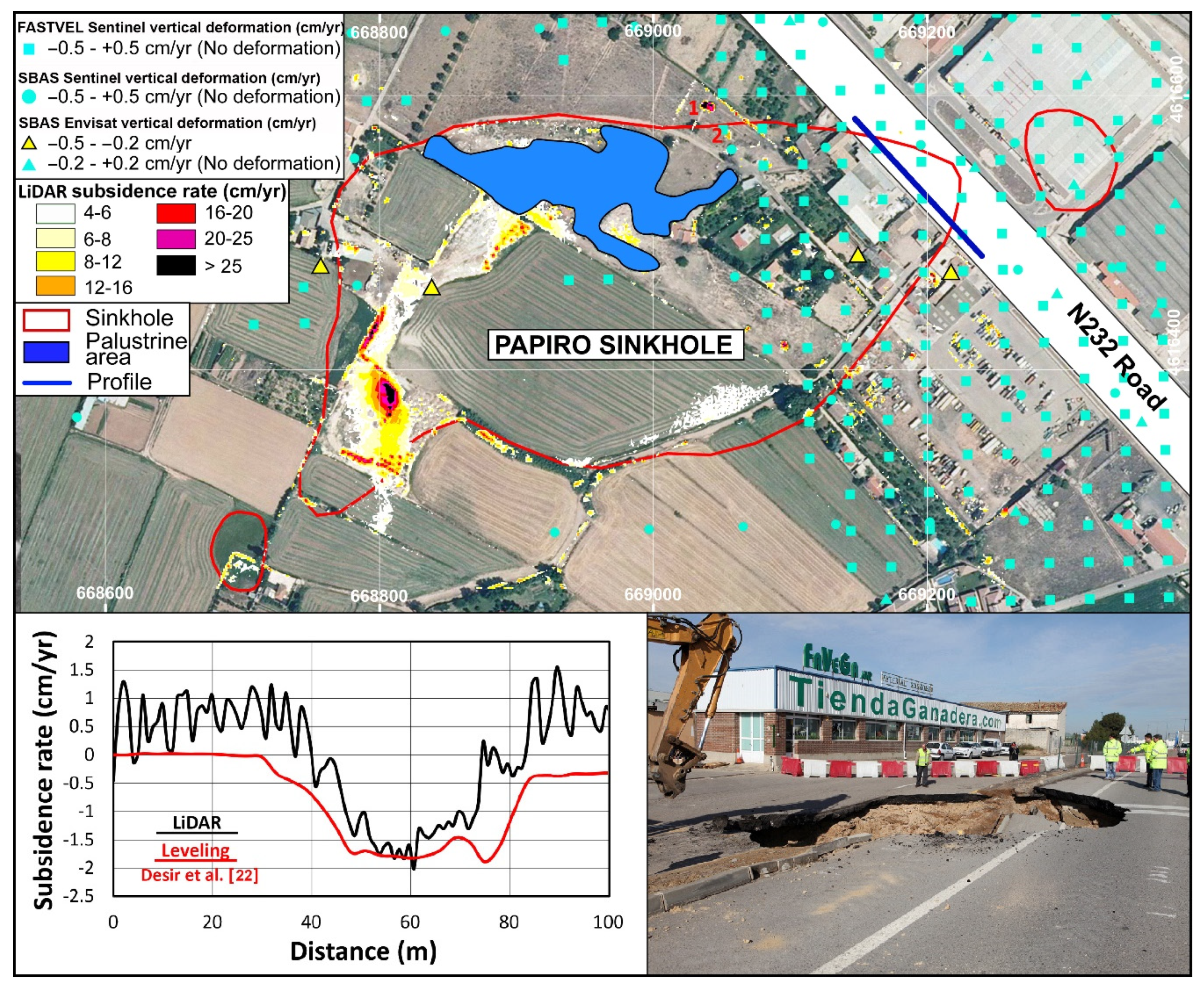
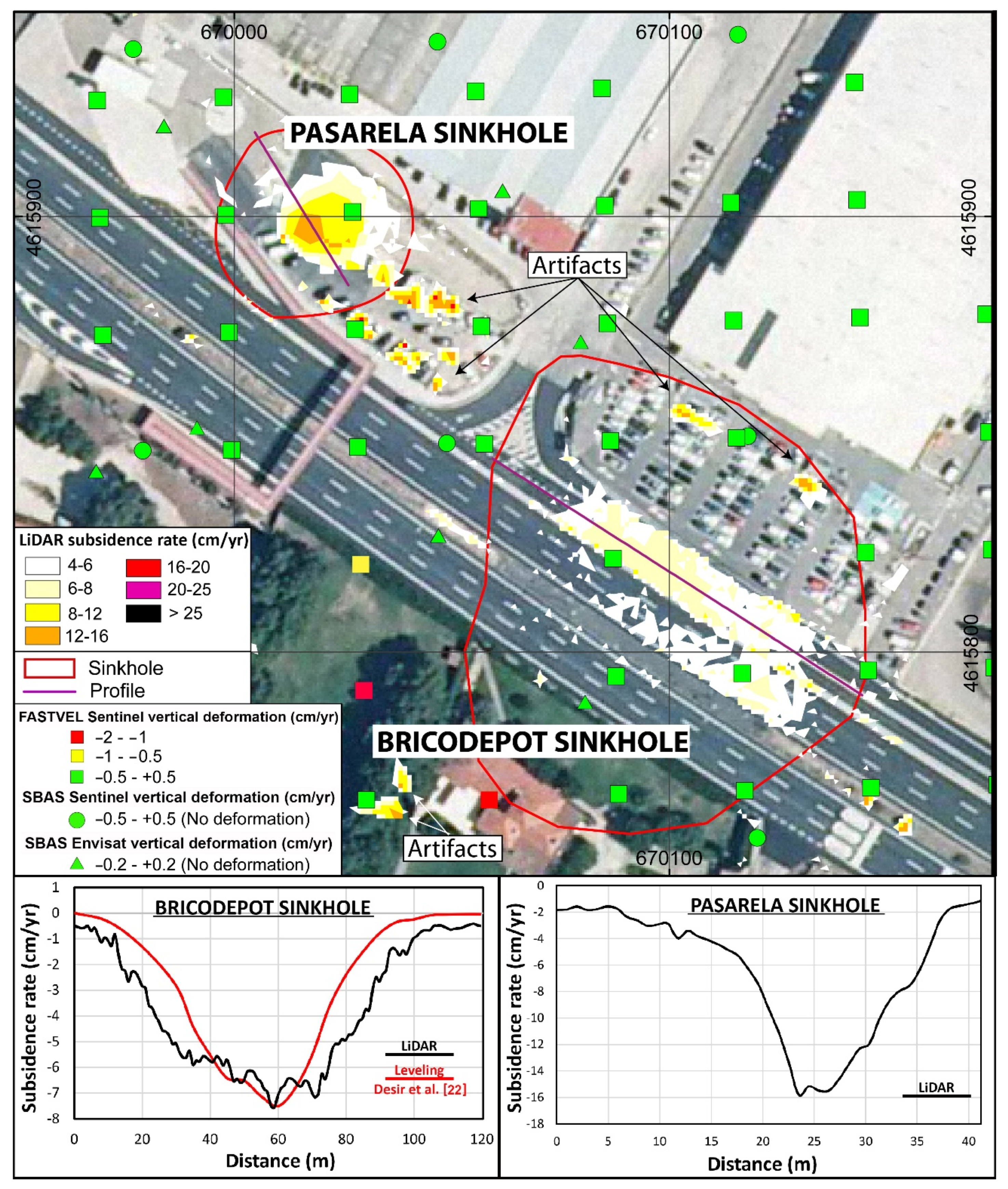
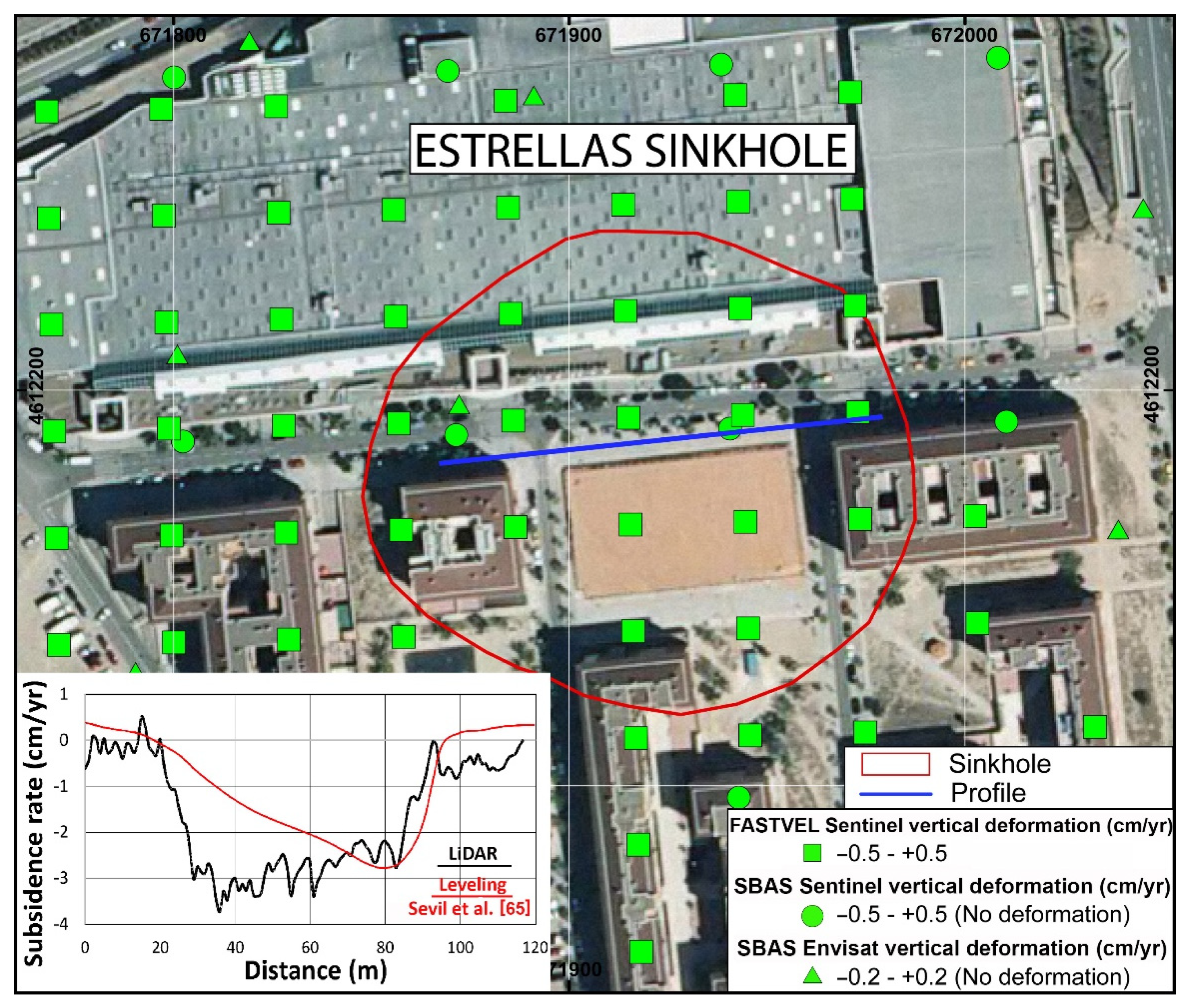
| Remote Sensing Method | Airborne LiDAR (2010–2016) | SBAS Envisat (2003–2010) | SBAS Sentinel (2014–2021) | SBAS Sentinel (2019–2021) | FASTVEL Sentinel (2019–2021) |
|---|---|---|---|---|---|
| Detected | 101 (27.5%) | 7 (2%) | 5 (1.5%) | 21 (6%) | 23 (6.5%) |
| Undetected | 248 (62.5%) | 342 (98%) | 344 (98.5%) | 328 (94%) | 326 (93.5%) |
Publisher’s Note: MDPI stays neutral with regard to jurisdictional claims in published maps and institutional affiliations. |
© 2021 by the authors. Licensee MDPI, Basel, Switzerland. This article is an open access article distributed under the terms and conditions of the Creative Commons Attribution (CC BY) license (https://creativecommons.org/licenses/by/4.0/).
Share and Cite
Guerrero, J.; Sevil, J.; Desir, G.; Gutiérrez, F.; Arnay, Á.G.; Galve, J.P.; Reyes-Carmona, C. The Detection of Active Sinkholes by Airborne Differential LiDAR DEMs and InSAR Cloud Computing Tools. Remote Sens. 2021, 13, 3261. https://doi.org/10.3390/rs13163261
Guerrero J, Sevil J, Desir G, Gutiérrez F, Arnay ÁG, Galve JP, Reyes-Carmona C. The Detection of Active Sinkholes by Airborne Differential LiDAR DEMs and InSAR Cloud Computing Tools. Remote Sensing. 2021; 13(16):3261. https://doi.org/10.3390/rs13163261
Chicago/Turabian StyleGuerrero, Jesús, Jorge Sevil, Gloria Desir, Francisco Gutiérrez, Ángel García Arnay, Jorge Pedro Galve, and Cristina Reyes-Carmona. 2021. "The Detection of Active Sinkholes by Airborne Differential LiDAR DEMs and InSAR Cloud Computing Tools" Remote Sensing 13, no. 16: 3261. https://doi.org/10.3390/rs13163261
APA StyleGuerrero, J., Sevil, J., Desir, G., Gutiérrez, F., Arnay, Á. G., Galve, J. P., & Reyes-Carmona, C. (2021). The Detection of Active Sinkholes by Airborne Differential LiDAR DEMs and InSAR Cloud Computing Tools. Remote Sensing, 13(16), 3261. https://doi.org/10.3390/rs13163261








